Tips For Gardening At Home
In the Vegetable Gardening for Beginners Guide, we cover how to start a vegetable garden from scratch, which vegetables to grow, and when to plant what. This year, we've added a "starter" garden plan consisting of easy-to-grow vegetables, companion planting techniques, and some lovely flowers!
Vegetable Gardening for Beginners
Why garden, you ask? How about enjoying the best vegetables and fruit you've ever eaten? If you've never tasted garden-fresh food, you will be amazed by the sweet, juicy flavors and vibrant textures. There's absolutely nothing quite like fresh veggies, especially if you grow them yourself—which you can!
It may seem daunting at first, but gardening is a very rewarding hobby. On this page, we'll highlight the basics of vegetable gardening and planning: how to pick the right site for your garden, how to create the right-size garden, and how to select which vegetables to grow.
Pick the Right Location
Picking a good location for your garden is absolutely key. A subpar location can result in subpar veggies! Here are a few tips for choosing a good site:
- Sunny spot:Most vegetables need 6 to 8 hours of direct sunlight per day. There are a few veggies (mostly the leafy ones) that will tolerate some shade.
- Drains well and doesn't stay wet: If you have poorly drained soil where water pools, plant veggies in a raised bed or raised row for improved drainage. Wet soil means wet roots, which can turn into rotted roots. If you have rocky soil, till and remove the rocks, as they will interfere with root growth and make for weaker plants.
- Stable and not windy:Avoid places that receive strong winds that could knock over your young plants or keep pollinators from doing their job. Nor do you want to plant in a location that receives too much foot traffic or floods easily. Plant in a location that would make Goldilocks smile—somewhere that's "just right."
- Nutrient-rich soil. You soil feeds your plants. If you have thin, nutrient-poor soil, you'll have poor, unhealthy plants. Mix in plenty of organic matter to help your plants gro. See how to prepare you soil for vegetable plants.
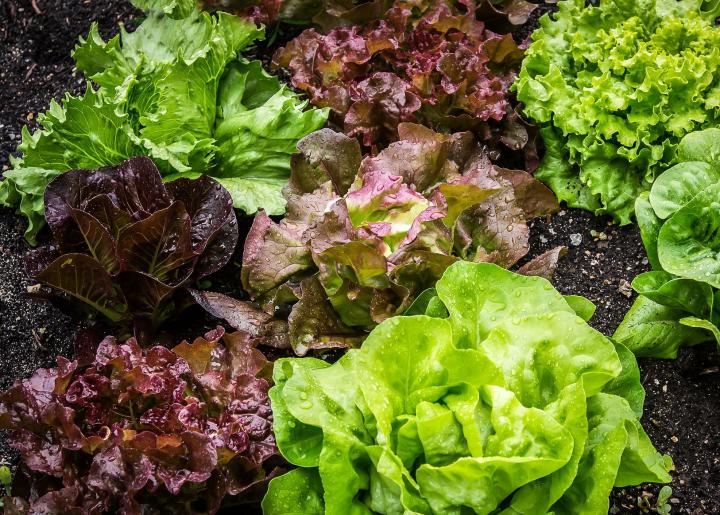
Choosing a Plot Size: Start Small!
Remember: It's better to be proud of a small garden than be frustrated by a big one!
One of the most common errors that beginners make is planting too much too soon—way more than anybody could ever eat or want! Unless you want to have zucchinis taking up residence in your attic, plan your garden with care. Start small, and only grow what you know you and your family will eat.
Size of Garden
- If planting in the ground, a 10' x 10' garden (100 square feet) is a managable size. Pick 3 to 5 of your favorite vegetables and buy 3 to 5 plants of each one.
- If planting in a raised bed, a 4' x 4' or 4' x 8' is a good beginner size. See our Raised Garden Bed Guide which covers the benefits of raised beds, how to build a raised bed, and what type of soil to fill a raised bed with.
- If you want to go bigger, a 12' x 24' garden in the ground is probably the biggest a first-timer should go. For example, a garden that feeds a family of four could include: 3 hills of yellow squash; 1 mound of zucchini; 10 assorted peppers; 6 tomato plants; 12 okra plants; a 12-foot row of bush beans; 2 cucumbers on a cage; 2 eggplant; 6 basil; 1 rosemary, and a few low-growing herbs such as oregano, thyme, and marjoram.
- Whatever the size of your garden: Every four feet or so, make sure that you have paths that allow you to access your plants to weed and harvest. Just make sure that you can reach the center of the row or bed easily without stepping on the soil.
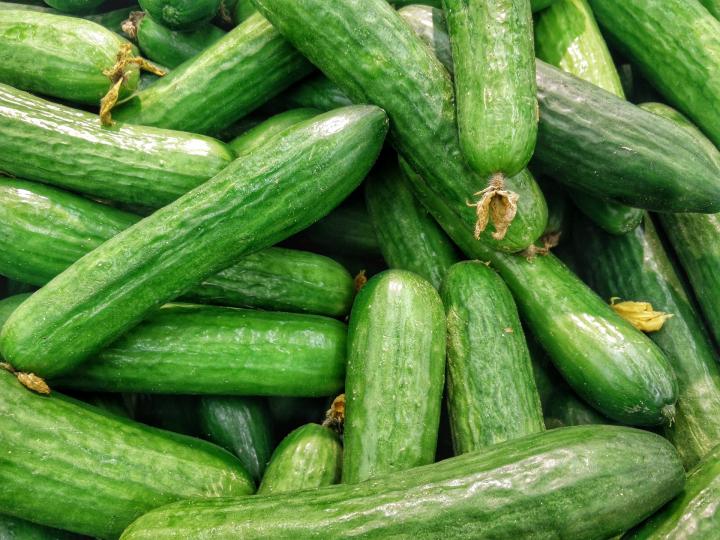
Choosing Vegetables
As a beginner, start by choosing easy vegetables that are also productive. We've listed ten easy vegetable below. However, it would also be wise to contact your state's Cooperative Extension Service to find out what plants grow best in your area. For example, if you live in an area with extremely hot weather, vegetables that prefer cooler temps may struggle.
Top 10 Easy Vegetables
(Tip: Click on a veggie's name to see its detailed Growing Guide.)
- Lettuce
- Green beans
- Radishes
- Tomatoes (bush variety or cherry are easiest)
- Zucchini
- Peppers
- Beets
- Carrots
- Chard, Spinach, or Kale
- Peas
Mix in flowers such as marigolds—which discourage pests, attracts pollinators, and adds some color!
Five tips for choosing vegetables:
- Choose what you (and your family) like to eat. If no one likes brussels sprouts, don't bother planting them! But if your kids love green beans, put more effort towards growing a big crop of beans.
- Be realistic about how many vegetables your family will eat. Be careful not to overplant, as you will only stretch yourself thin by trying to take care of tons of plants! (Of course, you could always give excess veggies away to friends, family, or the local soup kitchen.)
- Consider the availability of veggies at your grocery store. Maybe you want to grow tomatillos, instead of cabbage or carrots, which are readily available. Also, certain veggies are so far superior when homegrown, it's almost a shame not to consider them (we're thinking of garden lettuce and tomatoes). Also, homegrown herbs are far less expensive than grocery store herbs.
- Be prepared to take care of your plants throughout the growing season. Going on a summer vacation? Remember that tomatoes and zucchinis are growing strongest in the middle of summer. If you're gone part of the summer, you need someone to look after the crops or they will suffer. Or, you could just grow cool-season crops such as lettuce, kale, peas, and root veggies during the cooler months of late spring and early fall.
- Use high-quality seeds. Seed packets are less expensive than individual plants, but if seeds don't germinate, your money—and time—are wasted. A few extra cents spent in spring for that year's seeds will pay off in higher yields at harvesttime.
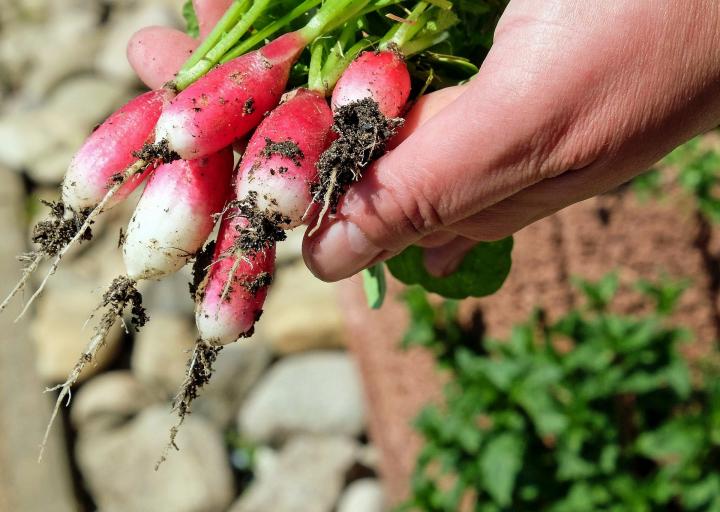
Where and When to Plant
If you are simply growing two or three tomato plants, this process is easy. But if you plan to grow a full garden, you need to consider:
- Where will each plant go?
- When will each vegetable need to be planted?
Here are a few guidelines for arranging your vegetables:
- Not all vegetables are planted at the same time. "Cool-season" vegetables such as lettuce and brocoil and peas grow in cooler weather of early spring (and fall). "Warm-season" such as tomatoes and peppers and cucumbers aren't planted until the soil warms up in late spring and summer.
- Plant tall veggies (such as pole beans on a trellis or sweet corn) on the north side of the garden so they don't shade shorter plants. If you do get shade in a part of your garden, save that area for small, cool-season veggies. If shade is unavoidable in parts of your garden, save those areas for cool-season vegetables which appreciate shade as the weather heats up.
- Most veggies are annuals (planted each year). If you're planning on growing "perennial" crops such as asparagus, rhubarb, and some herbs, provide permanent locations or beds.
- Consider that some crops mature quickly and have a very short harvest period (radishes, bush beans). Other plants, such as tomatoes, take longer to produce, but also produce for longer. These "days to maturity" are typically listed on the seed packet.
- Stagger plantings. You don't want to plant all your lettuce seeds at the same time, or all that lettuce will need to be harvested at around the same time! Stagger plantings by a few weeks to keep 'em coming!
When to Plant What
Every region has a different planting time based mainly on their weather, and every vegetable has its temperature preferences, too. See the Almanac's Best Planting Dates—a gardening calendar customized to your local frost dates. Just enter your zip code (or postal code in Canada)!
For specific planting information, see our individual Grow Guides for over 100 popular vegetables, herbs, and fruit. For each crop, we provide specific information about how to plant, grow, and harvest, including watering and fertilizing and pest control!
A Starter Beginner Garden Plan
To help out beginners, we thought that it may be useful to see a garden design. Here is an example of a starter family garden using mainly of the common easy-to-grow vegetables listed above. It also features companion planting (the practice of placing plants that thrive together next to each other).
You'll see that we have given the garden decent-sized paths and mixed in a few herbs and flowers, too. Frankly, if we had grown this garden in our very first year, we would be thrilled! In planning the garden this way, we have made it so much easier for you to succeed with it.
Click here to see the full plant list, number of plants, spacing, and spacing in rows.
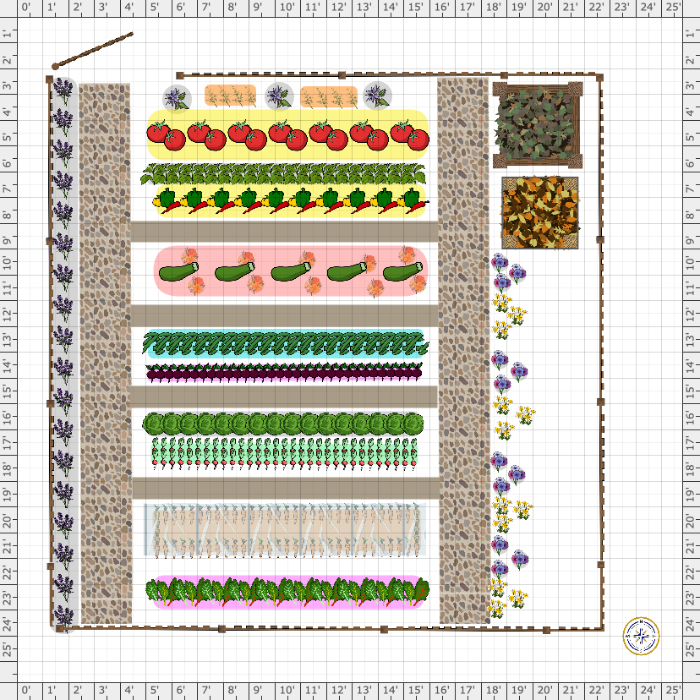
Garden Planning Tool
The Old Farmer's Almanac offers an excellent online garden planning tool which makes your garden planning fun and easy. With this tool, draw your garden plan on the computer and drop in your preferred vegetables, and it automatically calculates the proper spacing for each type of crop! This way, you don't waste seed or crowd your plants. The Garden Planner automatically pulls in the frost dates for your specific location, identifies easy vegetables, and even identifies companion plants. Then you can print out your plan and the tool reminds you of your seeding and harvesting dates for every vegetable!
Plus, you'll see many free garden plans for inspiration! Over time, you'll see that this tool also provides "crop rotation" so that if you plan a second season, you can properly reposition your plants to avoid pests and disease.
With new gardeners in mind, we offer a FREE week to try the Garden Planner—ample time to plan your first garden. Check it out here: http://gardenplanner.almanac.com/
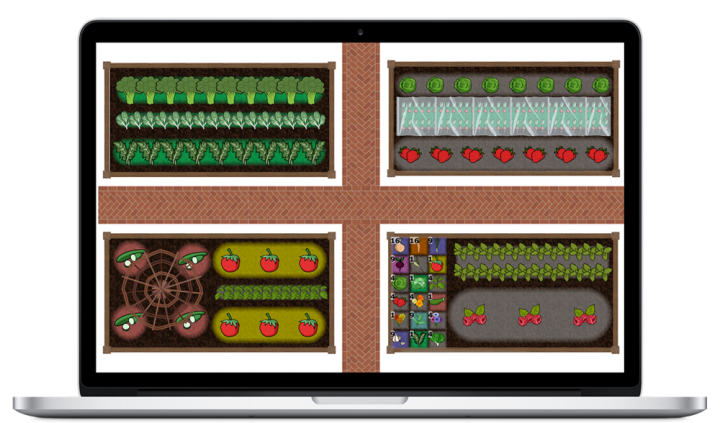
Photo: Almanac Garden Planner. Earth's most popular tool for planning your garden. Try it free for 7 days.
Any questions or advice about starting your garden? Check out some of the comments below. Many of your questions may have been answered already by our Almanac community or you are welcome to add your own comment. Happy gardening!
Tips For Gardening At Home
Source: https://www.almanac.com/vegetable-gardening-for-beginners
Posted by: howletthanceseles1941.blogspot.com

0 Response to "Tips For Gardening At Home"
Post a Comment